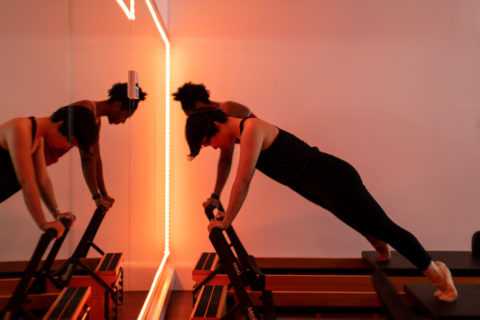Many people don’t know, but Pilates also works as a physical rehabilitation therapy, chronic pain or post-operative recovery.
Besides being a method to maintain muscle strengthening, posture alignment and physical conditioning and flexibility, Pilates is an excellent alternative for the recovery of patients affected by different types of pathologies. Pilates exercises treat a variety of diseases, such as:
- Low back pain;
- Fibromyalgia;
- Column deviations;
- Scoliosis;
- Herniated disc.
How Pilates helps healing from injuries?
Pilates exercises contribute to the rehabilitation of joints, which are responsible for supporting part of the body weight and providing mobility, such as the knee and hip.
The method is very effective for the physical rehabilitation of clients because the movements re-educate the spine, improve posture, strengthen the muscles, relieve tension and muscle fatigue and increase physical conditioning. Besides, the exercises performed during the Pilates class always work on breathing and concentration in each movement.
It’s worth saying that besides treating illnesses, Pilates prevents the development of new injuries, as the affected area becomes more resistant to impacts. However, for the client to achieve these benefits, the techniques of the method need to be applied according to the condition and goal of each person.
For example, in case of an injury less than 3 months old, Pilates can be used to stabilize the affected area. Depending on the healing phase, you must first protect the area from aggravating the injury, and then include a gradual progression of movement for complete rehabilitation. So, the Pilates exercises can be applied to avoid the intensification of inflammation.
It means that the controlled movements performed during a Pilates class can guarantee the restoration of normal movements of the joints and tissues (muscles, tendons, ligaments, among others), improving the function and correct movements.
Another advantage of Pilates in the recovery of injuries is the improvement of local metabolism, increasing the circulation of anti-inflammatory and analgesic substances.
Many people can confuse Pilates with Physiotherapy, perhaps because Pilates practitioners are usually physiotherapists or because some exercises are common in both areas. In some cases, Pilates sessions are already enough for the rehabilitation of clients, but in others, there is a need for physical therapy sessions as well. In other words, the two activities can be developed in parallel.
In conclusion, the practice of Pilates is effective both in preventing and treating injuries caused by various factors. Therefore, worn joints due to aging, chronic pain caused by poor posture when driving, working for hours sitting, among others, can be treated with Pilates.
Whether for physical rehabilitation or keeping your health up to date, it’s important to have a qualified professional to create an exercise plan that respects your limitations and determines the number and duration of sessions and short, medium and long-term goals. Come visit us and start your Reformer Pilates classes at the Kore Gallery!






